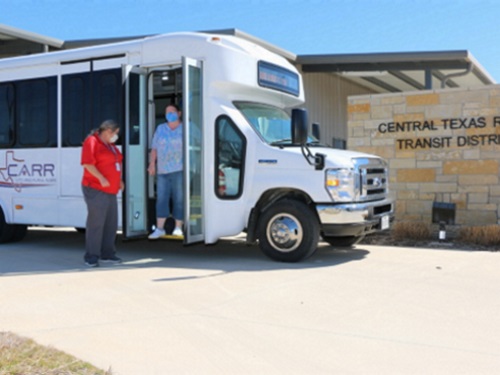A growing shortage of small buses is creating a “burgeoning crisis” in the small bus industry that threatens the ongoing operations of rural, small-city, paratransit and nonemergency medical transportation providers across the nation.
[Above photo by TxDOT]
That’s the warning delivered by the Community Transportation Association of America, the American Public Transportation Association, and the American Association of State Highway and Transportation Officials in an October 3 letter sent to the U.S. Department of Transportation.

“Today, the demand for small buses, particularly body-on-chassis vehicles, far outstrips supply with estimates of 20,000 small bus purchases currently backlogged,” the groups said in their letter. “We need your assistance in securing more chassis for the small bus marketplace so the trips [provided by] these types of buses can safely continue.”
The letter highlighted recent dialogue among transit agencies, state departments of transportation, bus dealers, and bus manufacturers regarding the current challenging state of the small bus marketplace:
- A survey of state DOTs last month revealed that three quarters of them feel an “unprecedented level of concern” regarding standard vehicle replacements and maintaining a state of good repair, with more than one-half of agencies having had a small bus purchasing contract or agreement terminated in 2022.
- Bus dealers predict the small bus backlog to eclipse 20,000 nationwide in 2023, and expect full recovery of the market to take between five to seven years.
- The largest small bus manufacturer currently has one of seven manufacturing facilities up-and-running, and can only meet 25 percent of demand.
- Prices for these vehicles are running 30 percent to 70 percent above pre-pandemic levels.
CTAA, APTA, and AASHTO jointly developed several potential solutions for USDOT to consider that would help alleviate the small bus shortage:
- Encourage chassis manufacturers to set aside units for vital public transportation and for small buses.
- Streamline current procurement regulations, with an emphasis on flexibility, because of the unprecedented nature of current small bus crisis. Use the vehicle backlog, nationally, to determine the timeframe for these procurement process changes.
- Expand the Federal Transit Administration’s proposed “Buy America” waiver to include passenger vans, while waiving “Buy America” requirements for small buses and vans when manufacturers are not able to guarantee delivery within 12 months or less of an order. Use this temporary waiver to incentivize manufacturers to locate production facilities in the United States.
- Offer clear guidance to FTA grantees on how to amend bus procurements or reprogram funds if vehicle delivery cannot be completed under the terms of the original procurement agreement.
“In summary, we strongly encourage USDOT to help the public transit industry secure additional chassis for the small bus market,” they said.
 Top Stories
Top Stories
Modal Administrators Speak at AASHTO Annual Meeting
December 5, 2025 Top Stories
Top Stories

